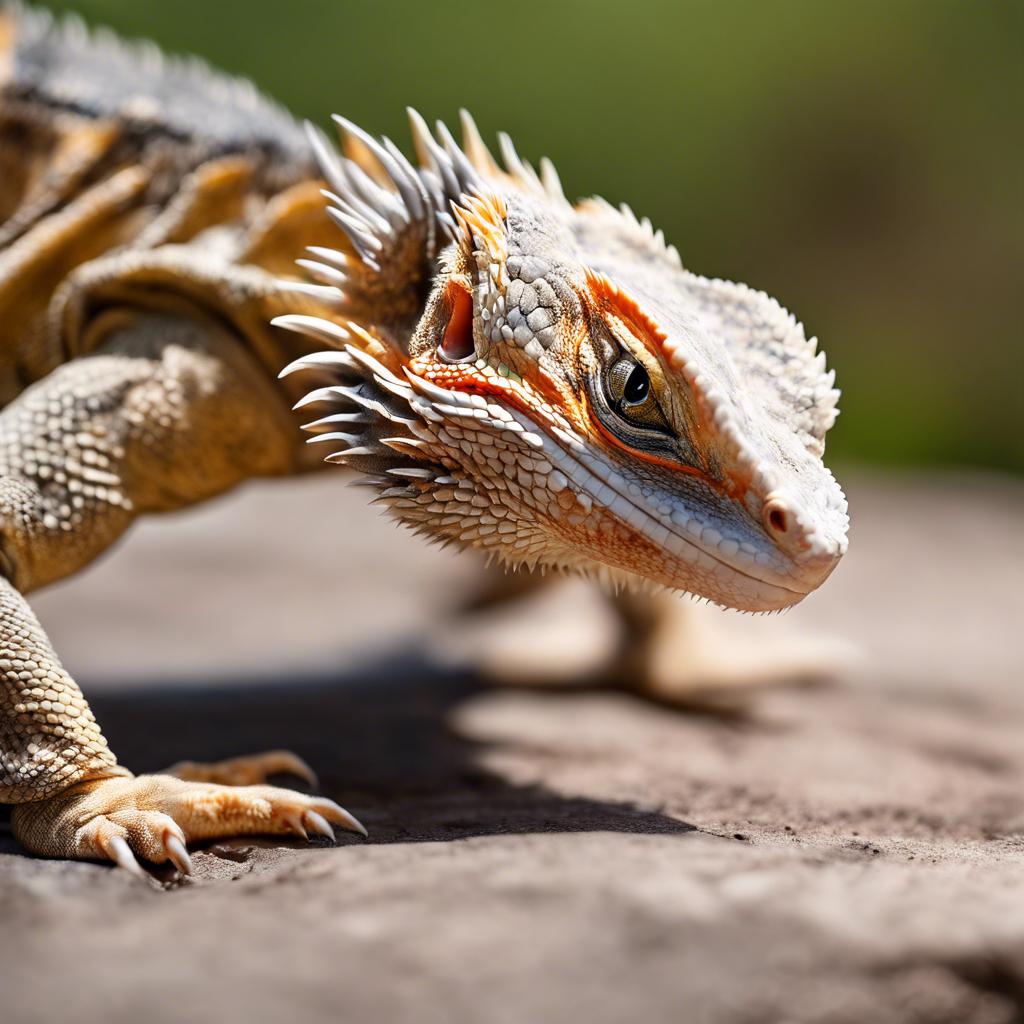Bearded dragons are popular reptile pets known for their unique appearance and docile nature. These reptiles are native to Australia and have become increasingly popular as pets due to their calm demeanor and relatively low maintenance requirements. However, it is important for potential owners to understand the behavior of bearded dragons in order to provide them with the best care possible.
Understanding the behavior of bearded dragons is crucial for their well-being and the well-being of their owners. By understanding their natural behaviors, owners can better interpret their needs and provide appropriate care. This includes understanding their feeding habits, social interactions, and environmental requirements. Additionally, understanding their behavior can help owners identify signs of stress or illness, allowing for early intervention and treatment.
Key Takeaways
- Bearded dragons have unique behaviors and personalities that require understanding and patience from their owners.
- While bearded dragons have a strong bite force, they are unlikely to bite off a finger unless provoked or mistreated.
- Factors such as stress, illness, and improper handling can contribute to bearded dragon aggression.
- Proper handling techniques and a comfortable environment can help prevent injuries and illnesses in bearded dragons.
- Responsible ownership includes providing proper nutrition, monitoring for common health issues, and taking preventative measures to ensure the well-being of bearded dragons.
The Bite Force of Bearded Dragons
One aspect of bearded dragon behavior that often raises questions is their bite force. While bearded dragons do have teeth, their bite force is relatively weak compared to other animals. The strength of a bearded dragon's bite is influenced by factors such as the size and health of the individual, as well as the circumstances surrounding the bite.
In comparison to other animals, bearded dragons have a relatively low bite force. For example, a bearded dragon's bite force is much weaker than that of a dog or a crocodile. This is due to the structure of their jaws and teeth, which are adapted for crushing and grinding rather than tearing flesh. While a bearded dragon's bite may cause discomfort or minor injury, it is highly unlikely that they could bite off a finger or cause serious harm.
Can Bearded Dragons Bite Off a Finger?
There is a common myth that bearded dragons have the ability to bite off a finger. However, this myth is not based in reality. Bearded dragons do not have the jaw strength or anatomy to bite off a finger or cause serious harm to humans.
The jaw structure of a bearded dragon is not designed for tearing or biting off large pieces of food or prey. Their jaws are relatively weak and their teeth are small and blunt. While a bearded dragon may bite if they feel threatened or cornered, their bites are typically more of a defensive response rather than an attempt to cause harm.
It is important to note that while bearded dragons may not have the ability to bite off a finger, their bites can still cause injury. Their teeth are sharp and can puncture the skin, leading to bleeding and potential infection. It is always important to handle bearded dragons with care and respect their boundaries to avoid any potential bites.
Factors that Influence Bearded Dragon Aggression
Bearded dragons are generally docile and friendly pets, but there are certain factors that can influence their aggression. It is important for owners to be aware of these factors in order to prevent any potential aggression and ensure the well-being of their pet.
Environmental factors can play a significant role in bearded dragon aggression. If a bearded dragon's enclosure is too small or lacks proper hiding spots, they may become stressed and exhibit aggressive behaviors. Additionally, if the temperature or lighting in their enclosure is not properly regulated, it can also lead to increased aggression.
Health issues can also contribute to bearded dragon aggression. If a bearded dragon is in pain or discomfort due to an underlying health condition, they may exhibit aggressive behaviors as a result. It is important for owners to regularly monitor their pet's health and seek veterinary care if any concerning symptoms arise.
Handling and socialization can also influence bearded dragon aggression. If a bearded dragon is not properly socialized or handled incorrectly, they may become fearful or defensive, leading to aggressive behaviors. It is important for owners to handle their bearded dragons gently and consistently in order to build trust and prevent any potential aggression.
Handling Bearded Dragons Safely
Proper handling techniques are essential for the safety and well-being of both the bearded dragon and the handler. When handling a bearded dragon, it is important to approach them calmly and confidently. Avoid sudden movements or loud noises that may startle them.
To pick up a bearded dragon, gently scoop them up from underneath, supporting their body with your hands. Avoid grabbing or squeezing them, as this can cause stress and potentially lead to aggression. It is also important to support their body and limbs while handling them to prevent any potential injuries.
It is crucial to supervise interactions between bearded dragons and children or other pets. Children should always be supervised by an adult when handling a bearded dragon to ensure that they are gentle and do not accidentally harm the reptile. Other pets should also be closely monitored to prevent any potential aggression or injury.
Bearded Dragon Care: Providing a Safe and Comfortable Environment

Providing a safe and comfortable environment is essential for the well-being of bearded dragons. Bearded dragons require a spacious enclosure that allows for adequate movement and includes hiding spots for security. The enclosure should also be escape-proof to prevent any potential accidents or injuries.
Temperature and lighting are crucial aspects of bearded dragon care. Bearded dragons are ectothermic, meaning they rely on external heat sources to regulate their body temperature. The enclosure should include a basking spot with a temperature gradient, allowing the bearded dragon to thermoregulate as needed. Additionally, UVB lighting is essential for proper calcium metabolism and overall health.
The substrate used in the enclosure should be safe and easy to clean. Avoid using substrates that can cause impaction if ingested, such as loose sand or gravel. Instead, opt for substrates such as reptile carpet or paper towels that are safe for the bearded dragon to walk on and easy to clean.
Feeding Bearded Dragons: Ensuring Proper Nutrition
Proper nutrition is crucial for the health and well-being of bearded dragons. Bearded dragons are omnivorous, meaning they eat both plant matter and small prey items. A balanced diet for a bearded dragon should consist of a variety of vegetables, fruits, and insects.
Leafy greens such as collard greens, mustard greens, and dandelion greens should make up the majority of a bearded dragon's diet. These greens are high in calcium and other essential nutrients. Fruits can be offered as occasional treats, but should not make up a large portion of their diet due to their high sugar content.
Insects such as crickets, mealworms, and dubia roaches can be offered as a source of protein. It is important to gut-load these insects with nutritious foods before feeding them to the bearded dragon to ensure they receive optimal nutrition. Additionally, it is important to dust the insects with a calcium supplement to prevent calcium deficiency.
Common Health Issues in Bearded Dragons
Bearded dragons are generally hardy pets, but they are still susceptible to certain health issues. It is important for owners to be aware of these common health issues in order to provide appropriate care and seek veterinary attention if necessary.
One common health issue in bearded dragons is metabolic bone disease (MBD). MBD occurs when a bearded dragon does not receive adequate calcium or vitamin D3, leading to weak bones and other skeletal abnormalities. Symptoms of MBD include soft or deformed bones, difficulty walking or climbing, and tremors.
Respiratory infections are another common health issue in bearded dragons. These infections can be caused by bacteria or viruses and can lead to symptoms such as wheezing, coughing, nasal discharge, and lethargy. Respiratory infections can be serious if left untreated, so it is important to seek veterinary care if any concerning symptoms arise.
Parasites are also a common issue in bearded dragons. Internal parasites such as worms can cause digestive issues and weight loss, while external parasites such as mites can cause itching and skin irritation. Regular fecal exams and preventative treatments can help prevent parasite infestations in bearded dragons.
Preventing Injuries and Illnesses in Bearded Dragons
Preventing injuries and illnesses is essential for the overall health and well-being of bearded dragons. There are several steps that owners can take to minimize the risk of injuries and illnesses in their pets.
Providing a safe and appropriate enclosure is the first step in preventing injuries. The enclosure should be escape-proof and free of any potential hazards such as sharp objects or toxic plants. Regularly inspect the enclosure for any signs of wear or damage that could potentially harm the bearded dragon.
Proper hygiene is also important for preventing illnesses in bearded dragons. Regularly clean and disinfect the enclosure to prevent the buildup of bacteria or parasites. Wash your hands thoroughly before and after handling the bearded dragon to prevent the spread of any potential pathogens.
Regular veterinary check-ups are crucial for maintaining the health of a bearded dragon. A veterinarian experienced in reptile care can perform routine exams, provide vaccinations if necessary, and address any health concerns that may arise. Regular check-ups can help catch any potential issues early on and prevent them from becoming more serious.
Responsible Ownership of Bearded Dragons
In conclusion, understanding the behavior, needs, and care requirements of bearded dragons is essential for responsible ownership. By providing a safe and comfortable environment, proper nutrition, and regular veterinary care, owners can ensure the well-being of their bearded dragons.
It is important to remember that while bearded dragons are generally docile pets, they still have specific needs and behaviors that must be respected. Handling should always be done with care and supervision, and any signs of aggression or illness should be addressed promptly.
By being knowledgeable and responsible owners, we can provide the best possible care for our bearded dragons and ensure their health and happiness for years to come.
If you're curious about the potential dangers of owning a bearded dragon, you might be interested in reading an article titled “Can a Bearded Dragon Bite Off a Finger?” This thought-provoking piece, available on Reptile Wizard's website, explores the biting capabilities of these fascinating reptiles and provides valuable insights for owners and enthusiasts alike. To delve into this intriguing topic further, click here.
FAQs
Can a bearded dragon bite off a finger?
It is highly unlikely for a bearded dragon to bite off a finger. Their jaws are not strong enough to cause such damage.
Can a bearded dragon bite hurt?
Yes, a bearded dragon bite can hurt. They have sharp teeth and can cause puncture wounds.
Why do bearded dragons bite?
Bearded dragons may bite if they feel threatened or scared. They may also bite if they mistake a finger for food.
How can I prevent my bearded dragon from biting?
Handling your bearded dragon gently and regularly can help prevent them from feeling scared or threatened. Avoid feeding them with your fingers and always approach them slowly and calmly.
What should I do if my bearded dragon bites me?
Wash the wound with soap and water and apply an antiseptic. If the wound is deep or shows signs of infection, seek medical attention.

